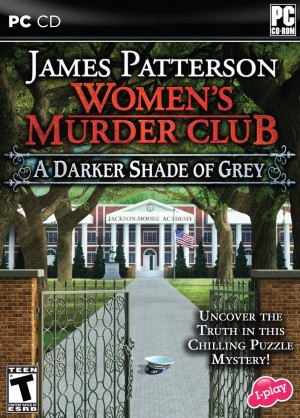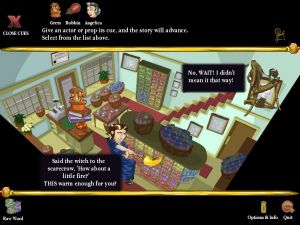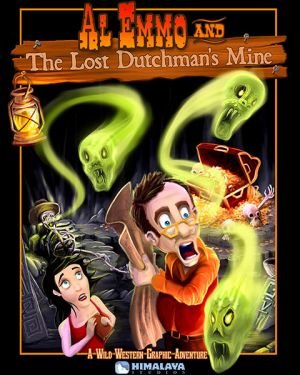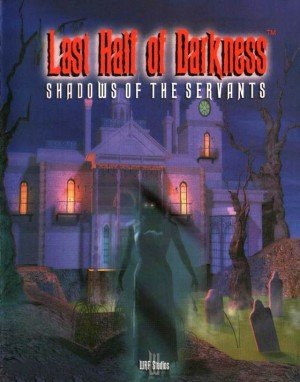Review for Women’s Murder Club: A Darker Shade of Grey

James Patterson is a very prolific writer: since his first novel was published in 1976, he’s written more than sixty books that have been extremely successful. He is particularly well known for his ongoing thriller series like Alex Cross, Maximum Ride and Women’s Murder Club. The latter, about the lives of four women in San Francisco – a police detective, a journalist, a coroner and an attorney – and their work together on various homicide cases, has already been adapted for a short-lived TV show, and was recently launched as a franchise in the so-called hidden object genre, under the creative direction of none other than Jane Jensen.
Working in partnership with Patterson, Jensen served as writer and game designer both for the first title in the series, Death in Scarlet, and the second installment, A Darker Shade of Grey. If you played the first game, which was already one of the more adventure-like casual games available, as Jane herself proudly declared, you’re likely expecting simply more of the same from the sequel. Surprisingly, however, A Darker Shade of Grey has moved even further away from typical hidden object games and into the “lite” adventure realm. It’s still a rather casual adventure, so to speak, but it’s more consistent and full-bodied than many other (superficially) similar games.
Before explaining what really sets A Darker Shade of Grey apart, it’s best to first introduce Lindsay, Claire, Cindy and Jill, the stars of Women’s Murder Club. Players are going to spend time with each of them to one extent or another, slowly but steadily getting to know them, their stories and their feelings. Lindsay Boxer is a strongly-motivated San Francisco P.D. with a penchant for hard, almost impossible cases. She often teams up with Dr. Claire Washburn, a medical examiner with whom Lindsay has been friends for ages. At the local bar where they like to hang out – a hard-boiled version of a Sex and the City girls’ night out – they are often met by Jill Bernhard, a successful district attorney who is the only non-playable character of the series (at least for now) and Cindy Thomas, the youngest of the lot and a reporter for the San Francisco Register.
After solving a string of murders related to human trafficking in Death in Scarlet, the four friends now embark on an even more intricate case, this one revolving around the deaths of two young recruits at the prestigious Jackson-Moore Academy: Winston, who apparently fell from a steep cliff, and Becky, who supposedly killed herself by jumping from a window. While the military is eager to label the deaths as simply unfortunate tragedies, something is wrong with the evidence and the convenient reconstruction of what happened leaves much to be desired, so Lindsay is convinced that something suspicious is going on within the Academy’s walls. When Claire finds traces of chloroform on a corpse, Lindsay starts digging a little more and finds out that someone is smoothing over the cracks, burying proofs and misdirecting police efforts to shed light on the mystery. Could Winston and Becky have known something they weren’t supposed to? When Cindy discovers an odd article from a Charleston newspaper, pieces starts to fall into place and the truth begins to surface.
A Darker Shade of Grey, in keeping with James Patterson’s tradition, is a solid thriller with an interesting political backdrop: there are subtle nods toward the Bush administration and the Iraqi war, but these references don’t feel overdone. On the contrary, they are cleverly intertwined within the main plot, grounded in the real-life experience of these past few years. Don’t expect a cautionary tale or an after-school special, though, because while the political background serves to flesh out the characters and highlight the drama, it never becomes judgmental. This balance between contemporary issues and a classical whodunit is achieved thanks to the successful match of Patterson and Jensen: while the genial Gabriel Knight author is perhaps more comfortable with eerie atmosphere, occult backgrounds and philosophical themes, the combination with Patterson’s often gritty realism is a smooth one. Their synergy has produced a group of compelling characters who demonstrate both Patterson’s curt style and Jensen’s highly elaborate prose. This blend grants a peculiar flavor to these Women’s Murder Club games: plucky and sassy enough to please noir and hard-boiled fiction fans, but also meditative and emotional, like a good psychological drama.
There is no doubt that the heart of the series is its characters, and I’m pleased to say that A Darker Shade of Grey excels in this regard: Lindsay, Claire and Cindy are well-rounded, believable characters that players will start to care about. Not only is their depiction respectful to the book series, which crossover fans will surely appreciate, but their personalities are fleshed out nicely enough that even newcomers will feel like they’ve known them a long time. The dialogue between these characters fluently uses both the correct procedural language and the saucy slang that made the series a hit, and their conversations over coffee or on the telephone sound authentic. This is one of the greatest achievements of the writing: it’s pretty easy to portray an ongoing friendship over a series of novels, but to convey such a strong bond and strikingly illustrate the familiarity of these women over the course of a rather brief adventure is an impressive feat. Unfortunately, the supporting characters like the seamy general and kind-hearted police officer aren’t so generously detailed, and they tend to feel too stereotypical. While this is partly the result of the casual approach of the game, it’s a pity that more time wasn’t spent in detailing the characters outside of the three leads, as this fact somewhat hampers the impact of an otherwise riveting plot.
Technically, the game is fairly neat: the hand drawn background graphics are clear and display a convincing quality, full of little details like pin-up calendars affixed on the walls of the police station, musical posters besides the beds of the Academy cadets or different brands of liquors showcased in the bar where all the reporters hang out. Sometimes the screens are even slightly animated, with leaves blowing in the wind, dust dancing in sunlight and electric fans spinning around. The cutscenes that intersperse the gameplay are done in a graphic novel style that can be quite pleasant to look at, though the dialogue text bubbles can’t be manually advanced without skipping the entire sequence. Perhaps most importantly, all the objects required are easily distinguished and completely recognizable, saving a lot of frustration on part of the player. The interface is stylish and effective, and the documents you get a chance to read – coroner’s reports, old newspaper clippings or letters and diaries – are reproduced with a great eye for realism. Unfortunately, the music doesn’t fare quite as well. The main string-based orchestration can be enjoyable for the first half of the game, but the theme is always the same, and the repetition wears out its welcome long before the end of the game. There’s little else to discuss on the audio front, as the game is devoid of voice acting and quite sparing in sound effects.
Like its predecessor, A Darker Shade of Grey is broken into many distinct investigations, often involving at least two of the lead characters, during which you will visit a handful of locations to find the clues necessary to move on. Key areas to examine within each scene are often highlighted, which is either a helpful aid or excessive hand-holding, depending on how much challenge you desire. Interspersed throughout these locations are a variety of standalone puzzles and some minigames – like selecting the right chemical reagents for your forensic analysis or sorting sports equipment correctly. None of these should prove particularly difficult, but a number of hints are available, and they can be skipped entirely if so desired. Any assistance used counts against your overall point score, but such penalties seem to have no effect on the gameplay itself. At any moment during the investigation, you can access a folder where all the suspects are filed, along with evidence summaries and key information uncovered. The game is so streamlined that you’ll never really need to review it, but it can be helpful if you spend any time away from the game and need a refresher.
What really sets A Darker Shade of Grey apart from other casual games is that it is consistently adventure-oriented. The label “casual adventure” is quite appropriate in this case: while the gameplay is undoubtedly easy and extremely linear, it drops common casual conventions in order to present a more cohesive approach. In this way, story and gameplay are more intertwined, and most importantly, players are actually supposed to think and not simply scour for items on screen. In fact, this game all but completely abandons random hidden object challenges. There are still a few remaining scenes where you’ll need to collect scattered sets of objects, but even these segments provide a more realistic, straightforward approach. You’ll never have to look for an eggplant, an hourglass, or an elephant in a police office. Like any standard adventure, the objects you have to find are, more often than not, believably placed and relevant to the investigation at hand. That’s not to say that sometimes these segments aren’t a little whimsical – like collecting shreds of paper after a mischievous fan scattered them across a room – but gone entirely are the hunts for random mismatched assortments in absurd settings.
Besides minimizing the hidden object sequences, there are several other aspects of A Darker Shade of Grey that draw it nigh to a full-fledged adventure: exploration, dialogues and inventory combinations. Near the beginning of the game, Lindsay gets a chance to explore the Jackson-Moore dormitories while empty, and she has to sift through the numerous beds: all of them conceal something of their occupants, and players are required to do some deductive reasoning to successfully relate the new items with other evidence. Later, when she gets to interview the cadets, the game provides a rudimentary form of dialogue tree: a list of questions appears at the bottom of the screen and upon selecting one, a pre-determined cadet will move (raising a hand or scratching his nose or twitching a leg), indicating that he knows something. By clicking on him, the cadet will answer the question at hand. There’s even some non-linearity to these dialogues, as you must choose what investigative path you wish to follow. Of course, no vital information can be missed, but this is nonetheless an intelligent addition I hope to see more developed in future installments. Last but not least, A Darker Shade of Grey features a very basic use of inventory: many standalone puzzles can be solved only after the player correctly manipulates the environment with some inventory objects, and in a sequence reminiscent of Jensen’s own Gabriel Knight: Sins of the Fathers, players sometimes need to use an item with a character to answer their questions correctly.
While a diverting addition that adds nicely to the sense of player immersion, the sequences involving inventory are usually pretty straightforward, and the only real brain challenge in the game comes from the standalone puzzles and minigames. While the latter become somewhat repetitive and quite boring after a while – if real life archivists really used such a convoluted pattern-matching system to categorize their articles, I vote to abolish their profession – the puzzles are often quite good and surprisingly varied. My favorites were the task of deducing Winston’s locker number from the fragmented information the other cadets give about it, and another where Lindsay has to sort out flowers based on anagrams. In addition, there are occasional tile puzzles, jigsaws, and convoluted locks to pry open. Still, A Darker Shade of Grey isn’t a difficult game by any means, and chances are that an experienced player won’t even use the hints at your disposal. Even without them, an adventurer can reach the end in about three hours, which is a little on the short side even by casual game standards, so it’s hard not to be a little disappointed.
All in all, Women’s Murder Club: A Darker Shade of Grey is a pleasing casual adventure, ideal for a rainy afternoon and a nice diversion for mystery buffs and fans of Patterson’s work. Most importantly, it shows how successful the blend between casual mechanics and traditional adventure game features can be with some clever integration and a strong storyline to pull it all together. While the implementation is not as seamless as the one seen in the recent 3 Cards to Midnight, it does offer far more diversity of gameplay, and shows the series is definitely moving in the right direction. If the third game further develops the light adventure elements introduced here, and maybe even adds a little more exploration, Women’s Murder Club may just have what it takes to become an interesting thriller series that appeals to both casual game fans and full-time adventurers alike.



_capsule_fog__medium.png)























